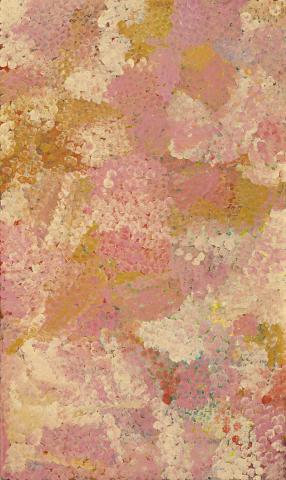PINK ALALGURA, 1993
EMILY KAME KNGWARREYE
synthetic polymer paint on canvas
151.5 x 90.5 cm
bears inscription verso: artist’s name and Delmore Gallery cat. 93E003
Commissioned by Delmore Gallery, via Alice Springs
Philip Bacon Galleries, Brisbane (label attached verso)
Gene and Brian Sherman collection, Sydney
Emily Kngwarreye’s painting career spanned only seven years, but in this relatively short time she not only bequeathed an extraordinary legacy of approximately 3,000 works, but moreover held the international spotlight as the most famous of contemporary Indigenous artists. Born at Utopia in central Australia, she came to prominence in the early 1990s with her unique depictions characterised by expressive colours, sinuous lines and multi-layering of dots that pay tribute to her birthplace, Alhalkere (Alalgura).
Pink Alalgura, 1993 executed in the middle years of Kngwarreye’s painting career derives from her ‘high-colourist’ phase, during which she expanded her colour palette to employ the whole spectrum in an attempt to capture the constantly shifting colours of the landscape evoked by seasonal change. This period was also characterised by her mark-making becoming looser and less defined.
Painted on a blue/grey ground, the composition is overlaid with areas of swirling pink, gold and cream dotting that spread across the canvas creating movement and depth. Works from this period have often been compared with the paintings of the early 20th century colourists, such as Monet or Delaunay, Kngwarreye’s paintings however, are not an optical science or a study of colour, but rather the artist’s highly personal response to the much-loved land of her birth.
SIMONE LANGEJAN
